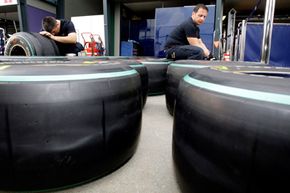Types of Tire Traction
Not all traction needs are created equal. The traction required by the family sedan, for instance, differs markedly from the traction sought by a Formula 1 race car or a Top Fuel Dragster.
The family sedan and other mass-produced vehicles have to function safely in a variety of weather conditions. As a result, the tires on these vehicles have grooves, otherwise known as tread -- the gouged lines that run around the outside circumference of the tire.
Advertisement
Water, oil, sand and gravel are all enemies of good traction, because they allow the wheels to spin without biting the ground and producing the friction necessary to move the car forward. A good tread pattern, suited for the purpose, acts to channel water off to the sides, away from the tire center. In mud or snow, deep treaded tires act almost like a gear, locking onto loose material instead of sliding over it like a typical tire would.
So what about the tires used for several types of race cars? They often lack any type of tread pattern at all. These smooth-surfaced tires, called "slicks," are made from a special rubber compound that's soft, sticky on the track surface and prone to wearing out much, much faster than the consumer-grade tires you buy for your personal car. Their advantage is that they provide tremendous traction. The downside is that they wear out so quickly that they have to be replaced for every race, if not more often [source: Pettit].
Is there a way to tell at a glance which tire will provide the type of traction you need? Find out how tires are rated by reading the next page.
